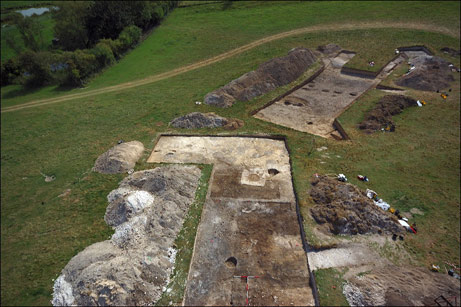The National Geographic magazine reveals that the remains of a prehistoric log-cabin village unearthed near Stonehenge may be part of the solution to the question of who built the site with the giant stones

A prehistoric village has been discovered in southern England, which was probably used by the builders of Stonehenge, scientists announced on January 30, 2007. The village is located about 2.8 kilometers from the famous circle of stones, including eight wooden houses dating back to 2500 BC, that is, about 4,500 years ago. An archaeological expedition uncovered near the Stonehenge site - the famous English circle of stones - a village that apparently served as a residence for pilgrims to the mid-winter festival held in the area.
The village is located in Dorrington Wells, about three kilometers from Stonehenge, and near the place where there is a wooden replica of the stone circle of Stonehenge.
At a press conference held by the "National Geographic" society, Mike Parker Pearson, an archaeologist from the University of Sheffield, reported that so far eight of the village's houses have been uncovered, which he believes to be about 25 houses. According to the archaeologists, this is the largest concentration of prehistoric huts ever discovered in the country.
The excavations, which began in 2003, were designed to uncover the remains of Stonehenge, a site located approximately 150 km southwest of London. The research, led by Dr. Mike Parker Pearson from the University of Sheffield in the UK, was conducted in collaboration with six British universities and was partially funded by "National Geographic". According to the researchers, the inhabitants of the place may have been Stonehenge builders, and others were pilgrims who came to participate in the sun worship held there.
The team uncovered eight cabins, each measuring about 5 square meters with a material floor and a central fireplace. Two larger buildings, surrounded by fences and ditches, were probably the homes of the village leaders or clergy, although they may have been intended to serve as dwellings for the spirits: the smaller huts were filled with the remains of cookware and other pottery, but no similar remains were found in the two huts the large ones, so the researchers estimate that they were left empty for a ceremonial purpose. A radar test conducted on the ground raises the possibility that the discovered site is only a small part of a huge prehistoric settlement. Pearson believes that tens, if not hundreds, of huts may be discovered there. According to him, "it seems that the whole valley is full of cabins".
In addition to the huts, there were also circles of dirt ditches surrounded by a single ring of wooden beams. "It can be determined that this is a wooden version of the Stonehenge site," says Pearson. According to the researchers, while the famous Stonehenge was an abode for the spirits of the dead, the wooden structure in Dorrington Wells symbolizes the "impermanence of life". Residents from all over the region flocked to it to celebrate life and bury their dead in the river, so they could reach the next world.
Carbon tests conducted by the researchers indicate that the settlement began in 2,500 BC, at the same time when the first stones were laid at Stonehenge. This figure, together with the discovery of a path leading between the settlement and Stonehenge, supports Pearson's assessment that "these two sites complement each other", and that "Stonehenge is only half of the complex".
The researchers estimate that Dorrington Wells was a residential village, while Stonehenge - where the remains of bodies that underwent post-mortem burning were discovered - served as a cemetery and memorial site. The two sites are linked to the Avon River by paths called Avenues - Sderot, and apparently this is the origin of the name Sderot.
